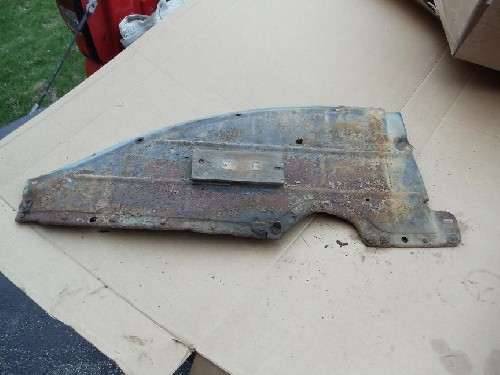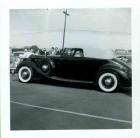|
Re: Ken's 1937 115C Touring Sedan
|
||||
|---|---|---|---|---|
|
Home away from home
|
I had the choke open, but didn't think to open the throttle plate. I might try that once the battery is charged up a little.
Also, I was thinking about it, and cranking speed really shouldn't affect compression. I put three pumps of SAE 30W oil into each cylinder prior to starting the compression test, perhaps the constant cranking had washed the cylinders down slightly by the time I got back to 5 and 6. Also, if my fuel pump diaphragm is bad, I could be dumping fuel straight into the crank case, which will also lower compression. I think the next step will be to get the fuel pump swapped out. I was going to rebuild it myself, but I decided that the cost difference doesn't justify the headache factor and potential for error. Then and Now automotive is only 90 minutes away, but they're only open M-F, so I'll probably ship the pump instead of driving it up there.
Posted on: 2011/4/16 12:38
|
|||
|
1937 120 1092 - Original survivor for driving and continued preservation. Project blog / Registry
1937 115 1082 - Total basket case, partial restoration, sold Hershey 2015 Project blog / Registry |
||||
|
||||
|
Re: Ken's 1937 115C Touring Sedan
|
||||
|---|---|---|---|---|
|
Home away from home

|
"One of the major reasons for damage to the flywheel ring gear is 12-volt conversions. The starter really SLAMS into the ring gear."
Good point. This would explain why car makers went to a different ring gear when they changed to 12 volts. Typically the same diameter flywheel but finer teeth in other words more teeth but smaller.
Posted on: 2011/4/16 13:02
|
|||
|
||||
|
Re: Ken's 1937 115C Touring Sedan
|
||||
|---|---|---|---|---|
|
Forum Ambassador

|
Ken - lots of ways to do a compression test. Assuming the engine has been running or in recent service:
- remove all the spark plugs - open both the choke & throttle valves - first test: run dry (no oil added) - watch the gauge as you pump thru several compression strokes, usually pressure will stop building after the 3rd compression stroke and this is the value to record. - IF values are low, then add oil as you did and run a second set of values to differentiate between rings and valves as the source of the loss. Others may well have different techniques but I think this is the commonly accepted method. I agree on the fuel pump, I used to rebuild them myself but the cost of good kits (don't buy NOS or even NORS) is only a bit less than the total cost from a good rebuilder like Gould or Terrill, among others. Current cost from Gould for a double-action Packard-type pump is about $98. Art Gould himself has been out of the busines for some years now, but on the one occasion where I had a problem - a water pump that got a little noisy after 3-4 years, there was no question about the warranty period - it was rebuilt again at no cost.
Posted on: 2011/4/16 13:21
|
|||
|
||||
|
Re: Ken's 1937 115C Touring Sedan
|
||||
|---|---|---|---|---|
|
Home away from home
|
Thanks for all the insights and tips. The history on the car is a bit fuzzy at best, but to the best of my knowledge, it's been started or driven only occasionally at best over the last 25 years, which is why I used the oil method. I also waited at least 3 compression strokes. I didn't have the throttle valve open, but I'm pleased with the numbers for now. Once I have it running well, then I'll worry about getting the perfect numbers!
Copy all about not using NOS rubber on any fuel system components! The fuel pump actually worked great about five weeks ago and now the carb end of the flex hose is completely dry when the motor cranks over. I'm about 95% positive the new E-10 gas ate right through the old pump. I'm not going to worry about it in the near future, but how easy are new ring gears (or a new ring gear/flywheel combo) to find? Are they a component unique to Packard, or something that cross-correlates to most automakers from that period?
Posted on: 2011/4/16 14:06
|
|||
|
1937 120 1092 - Original survivor for driving and continued preservation. Project blog / Registry
1937 115 1082 - Total basket case, partial restoration, sold Hershey 2015 Project blog / Registry |
||||
|
||||
|
Re: Ken's 1937 115C Touring Sedan
|
||||
|---|---|---|---|---|
|
Forum Ambassador

|
I'm not sure how easy ring gears are to find, but it's not a high-volume service part. They certainly are around, contact the usual Packard vendors. As to fit, they are usually broken off with a chisel, and the new one heated hot and then shrunk onto the flywheel. Not a bad job, but you'll need a good torch or high temperature oven. Or farm it out to an auto machine shop - it'll be a pretty routine operation for them.
Original factory spec for compression on a 1937 120 was 110 psi with the 6.6 CR head, 118 with the 7:1 head. Doing the test with the throttle valve closed would certainly limit the pressure you obtained so the results are better than you posted. In any case I wouldn't worry at all about the values you're getting, more than adequate for a good-running engine, and they may rise a bit as the engine sees some accumulated mileage. If your fuel pump inlet suction hose is not a recent replacement, it may well suffer the same fate as the pump diaphragm. Niagra Packards sells them with proper materials of construction.
Posted on: 2011/4/16 14:13
|
|||
|
||||
|
Re: Ken's 1937 115C Touring Sedan
|
||||
|---|---|---|---|---|
|
Home away from home
|
The 1937-1938 shop manual says I should see approximately 105 psi at cranking speed. I definitely think I should be close enough that it will run just fine; perhaps a ring job and/or refurbishing the head will be something to be done many years down the road when the rest of the car is tip-top. For now though, I'm not going to worry about it.
Posted on: 2011/4/16 14:22
|
|||
|
1937 120 1092 - Original survivor for driving and continued preservation. Project blog / Registry
1937 115 1082 - Total basket case, partial restoration, sold Hershey 2015 Project blog / Registry |
||||
|
||||
|
Re: Ken's 1937 115C Touring Sedan
|
||||
|---|---|---|---|---|
|
Forum Ambassador

|
A valve grind is perhaps more likely than a re-ring, but that's the reason to do the "dry" and with oil added compression test - it will tell you which. These types of engines normally needed a valve grind every 30-45,000 miles.
Forget it for now, go on to your other priorities would be my suggestion.
Posted on: 2011/4/16 14:24
|
|||
|
||||
|
Re: Ken's 1937 115C Touring Sedan
|
||||
|---|---|---|---|---|
|
Home away from home
|
One last question for the day. I pulled the passenger side inner fender well, and found this piece of wood bolted to it. Any thoughts on why it is there? There wasn't a corresponding piece on the other side.
Incidentally, when I pulled the fuel pump, nothing was hooked up to either port on the vacuum side of the pump.
Posted on: 2011/4/16 15:26
|
|||
|
1937 120 1092 - Original survivor for driving and continued preservation. Project blog / Registry
1937 115 1082 - Total basket case, partial restoration, sold Hershey 2015 Project blog / Registry |
||||
|
||||
|
Re: Ken's 1937 115C Touring Sedan
|
||||
|---|---|---|---|---|
|
Home away from home
|
In the tech session at Salado this year one of the presenters talked about flywheel ring gears. He said that a ring gear can be taken off of the flywheel and reversed so that the good portion of the teeth are facing the starter. He said that the ring gears wear on the front half part of the teeth and reversing them gives the starter drive essentially a new gear to engage. There is a procedure for doing this change which I will not get into now, but can describe if folks are interested. Of course all of this is based on the starter drive teeth being in good condition. I had never heard of doing this until Salado, but it may be worth a try.
(o{I}o)
Posted on: 2011/4/16 21:49
|
|||
|
We move toward
And make happen What occupies our mind... (W. Scherer) |
||||
|
||||

 (84.39 KB)
(84.39 KB)







